Having a pool in the backyard is part of the Australian dream. However, leaving a pool barren in your backyard just isn’t right. In fact, it is your choice of plants and landscaping that gives your pool its charm. Poolside plants add a sense of calmness and serenity to your pool area while also providing an inviting environment. You can also use them to ensure you have some privacy when sunbathing by the pool in summer. But when it comes to choosing the right plants, it can be difficult to make a decision.
Below we are going to list our top 7 favourite poolside plants and how to care for them!
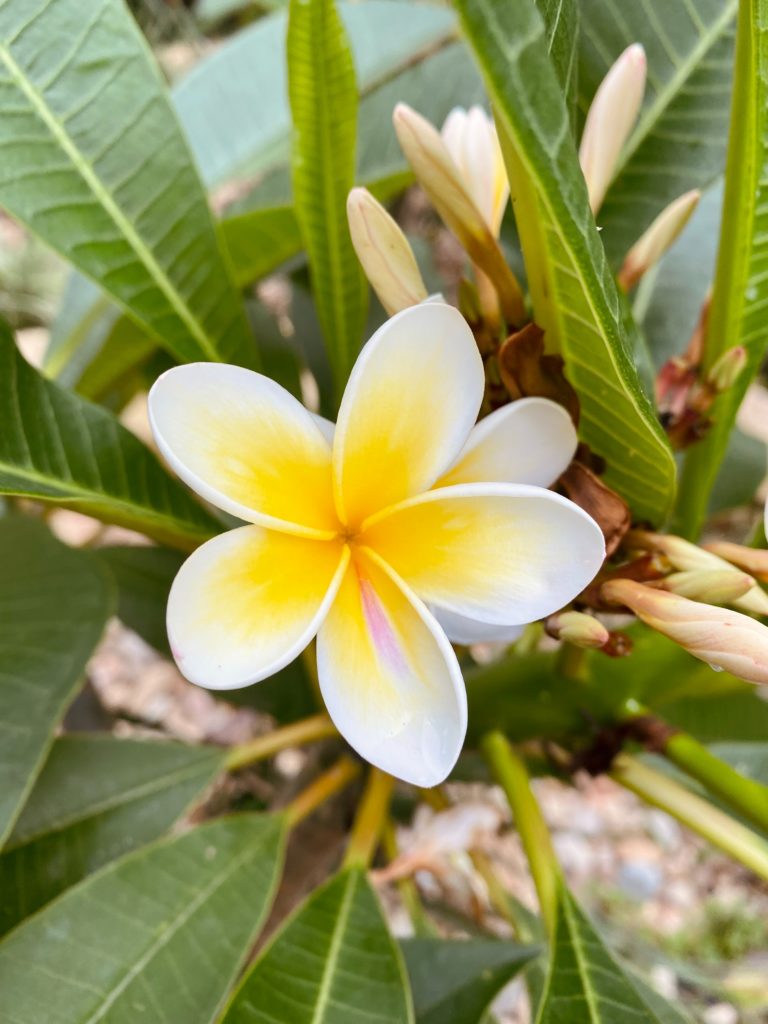
1: Frangipani
The frangipani is one of the most well-known tropical trees. It bears clusters of its iconic colourful and scented flowers that bloom during spring and summer. These flowers appear in clusters at the end of each branch on the tree and have a very distinctive fragrance. Unlike most flowering trees that bloom for only a few days or weeks, the frangipani blooms for months. This creates a stunning array of tropical colour around your pool.
The petals are waxy and the centre of the flower is a different colour to the outer petals. The most common colour combination is white and yellow, however they can range from a deep crimson to a pale pink, orange, and even yellow. With a wide variety of colours to choose from they are perfect for creating a bright, tropical atmosphere around your pool.
You should plant your frangipanis in winter to late spring in full sun. They will grow quite well in most soil types, however they do prefer a well-draining soil. Frangipani don’t like wet feet so if your are planning on growing your tree in a pot, ensure it is a well-draining pot with a free-draining potting mix.
Water frangipani only in spring and summer and stop watering completely during the cooler months. Let them dry out between waterings. Apply a phosphorus and potash rich fertiliser twice a year in spring and then in summer. This will promote a strong root system and beautiful flowers. Pruning isn’t usually required but you might want to prune back the tree to reduce the size or cut back dead branches. The are robust summer flowers.
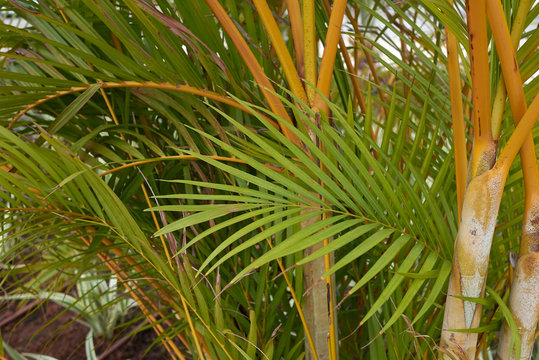
2: Golden Cane Palm
One of the most popular and attractive palms, the Golden Cane palm is named after its golden stems and beautiful yellow-green fronds. It is also known as the Butterfly Palm due the leaves that curve upwards, creating a butterfly look. The Golden Cane palm adds a fun tropical vibe to your pool, perfect for both your garden and for large pots, making it extremely versatile. Plant it in garden beds, or use it to decorate tiled or paved areas around the pool to bring a tropical feel to your seated poolside area. They can also help create privacy around your pool.
Golden Cane palm trees don’t shed many leaves, so you won’t have to worry about constant cleaning which, again, makes them great for seating areas, decking, as well as your poolside garden. Plant or gather together several potted palms and they create a welcoming atmosphere to your pool.
Golden Cane palms prefer a shaded area as direct sunlight may kill the leaves, destroying the stunning golden look of the palm. Mulch heavily to prevent the surface roots from drying out too quickly. Without mulch, your palms will still grow, but at a slower pace and with foliage that is less lush than a plant with mulch.
When watering Golden Cane palms, remember that mature plants can develop a very dense root system that can become matted. This can prevent water reaching all the roots. Ensure you heavily water garden plants and well oak potted plants to ensure the water soaks right through the root system.

3: Star Jasmine
A stunning climbing plant, perfect for training up trellises or around decks, star jasmine is well known for its dark green leaves and white flowers. It can also be used for thick, stunning ground cover, especially when matched with other dark green plants. They make an impressive addition to your poolside landscaping, creating a lush, relaxing ambience. Star jasmine grows to 1-2m and blooms in spring. It is a low maintenance plant, making it the perfect addition to any poolside landscaping.
Star jasmine loves full sun or part shade, but for the best flowers, ensure your plant gets plenty of sunlight. These vines will produce the most flowers if they get at least eight hours of sunlight a day. If you are using your jasmine as ground cover, make sure it isn’t being shaded my larger plants or trees as it might reduce the number of blooms.
Star jasmine isn’t picky about soil, however it will grow best in a mixture of moist and well-draining soil. If you are planting multiple plants as ground cover, space them out at least 5 feet apart to avoid overcrowding. Plants should be watered regularly, at least once a week, though you might need to increase your watering if the weather gets hot or dry, or if your jasmine is planted in a pot. If the top inch of soil is dry, it is time to water.
Jasmine is cold-hardy and can tolerate temperature as low as -12°C though it will grow and bloom best in temperatures around 20°C. they love humidity and thrive best in moderately moist environments.
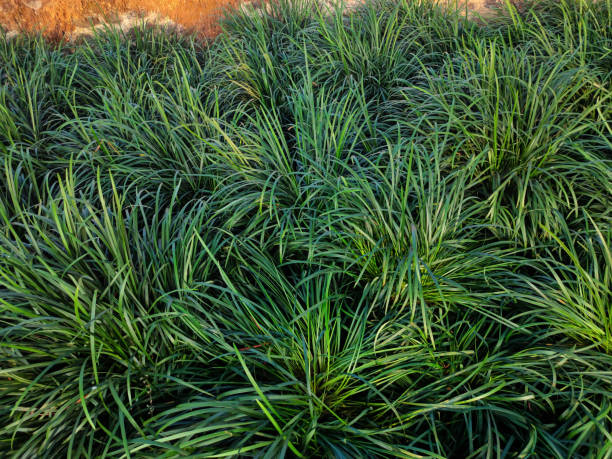
4. Mondo Grass
Mondo grass is a visually stunning plant that looks stunning around your poolside. They look great on their own around the pool or as part of poolside rock gardens. Also known as monkey grass, it is an evergreen perennial that makes a great groundcover or a standalone grass. It is an outstanding landscaping plant, with a multitude of uses.
Mondo grass is drought-resistant and grows up to 12 inches tall. It requires extremely minimal care but you do need to choose the right location for the best results. Planting in full sun will result in a light green plant while planting in the shade will result in a plant that is a dark green shade. Soil should be well draining and free of any competitive weeds.
Separate clumps into sections and plant 4-12 inches apart, depending on how quickly you want to fill in an area. Cover with loose soil but avoid covering the crown of the plant. Keep the soil moderately moist during its establishment.
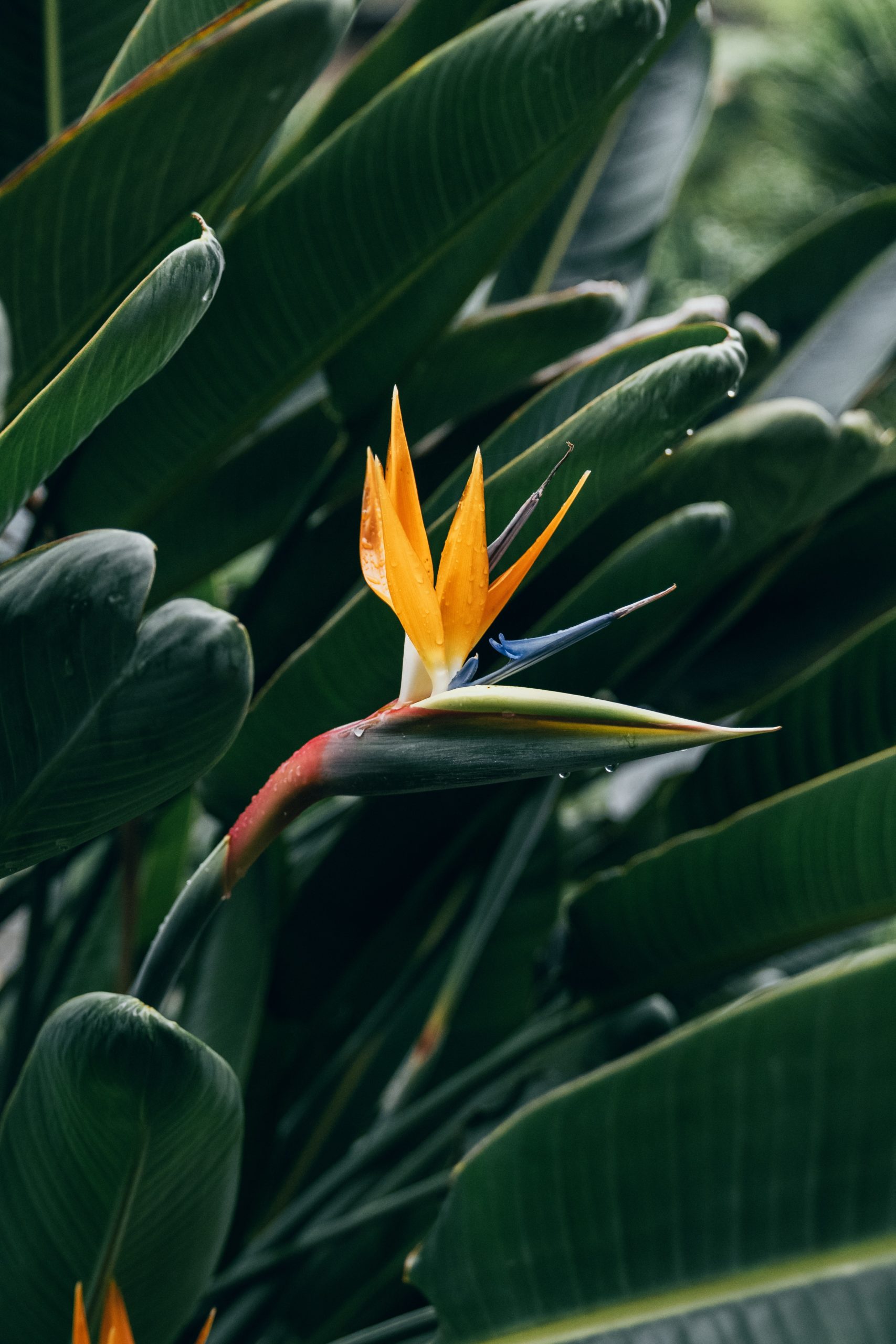
5: Bird of Paradise
Looking to create a tropical oasis in your backyard? Then the bird of paradise is plant you must add to your landscape. It is one of the spectacular and impactful flowering plants that can be grown in your garden around the pool or in containers. Their spectacular orange-red and blue flowers that look just like brilliant birds shooting out of the bright green foliage. It is ideal for poolscaping as it doesn’t shed and is strong enough to tolerate splashing from poolwater, unlike many other flowering plants.
Bird of paradise plant care isn’t difficult but they do need rich soil that is well draining and full sun. they grow best in 18-21°C but can be heavily damaged when temperatures dip below -4°C. You should divide in-ground plants at least every 5 years and remove any broken or dead leaves as they occur. You should also remove any spent flowers as they appear, as well. To avoid pests and diseases, make sure you water under the leaves or when the foliage can dry before nightfall. Avoid overwatering, to prevent root rot.
Dogs also enjoy nibbling on bird of paradise, but the seeds are toxic which cause abdominal pain and vomiting, so keep them away from your pets.
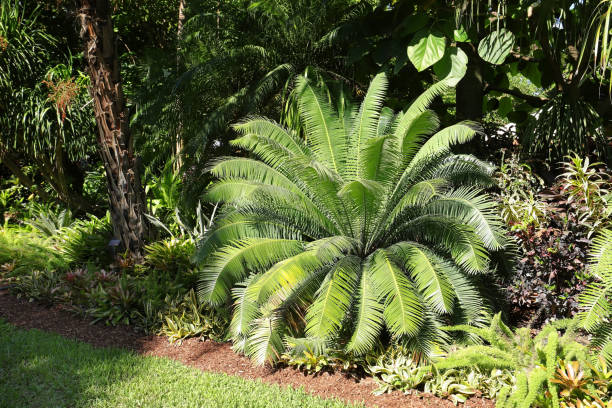
6: Cycad
A coastal plant, the cycad is adaptable and slow growing, making a fantastic, hardy plant to have in your poolside landscape. Also known as the sago palm, the cycad has striking green, almost architectural foliage and fan-like leaves. Not only does this make it look similar to a palm or fern, it also makes the cycad an excellent feature in any garden bed or container. It is perfect for creating that tropical resort look around your poolside as it will grow in most conditions. They grow well in garden beds as well as containers, with decorative containers working well to highlight their sculptural forms. Cycad, however, are slow growers so you will need to have some patience when growing this striking plant.
They grow best in part shade areas in a well-draining, loamy soil. You should water your cycad well in hot weather, especially if you choose to grow in containers and you will need to fertilise in summer with blood and bone. Cycad is ideal as both a single specimen or for mass planting to create a luxe tropical effect. It is ideal for poolside landscaping as well as in decorative containers that highlight its sculptural shape. Cycad live up to 100 years and often have multiple trunks. However, it is important to remember that all parts of this plant are toxic, so they might not be the best choice if you have pets or small children.
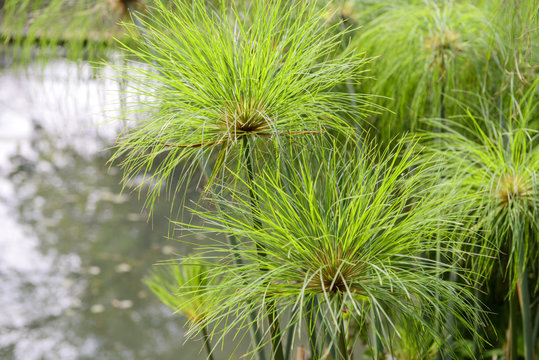
7: Egyptian Papyrus
Papyrus was once one of the most important plants in ancient Egypt. It was an integral part of creating paper, woven goods, fragrance, and food. In fact, papyrus manufacture has been traced back as far as the fourth millennium BCE. Papyrus is a sedge plant that loves moist, warm environments, making it ideal for growing around your pool or as part of a water garden. With the right landscaping, Egyptian papyrus can create a lush, tropical, and exotic mood to your poolside. It loves water and thrives not only in bogs and shallow ponds, but also in clay. It pairs perfectly with the tall, skinny Equisetum or Horsetail plant to further enhance that exotic look and feel.
Egyptian papyrus is also sometimes called Umbrella plant due the sprays of foliage at the top of the stems that radiate out like the spokes on an umbrella. The stems are rigid and have a white pith inside that was once the source of the iconic papyrus “paper”. Papyrus plants can reach 3m tall, making them a fantastic, dramatic choice as a poolside plant.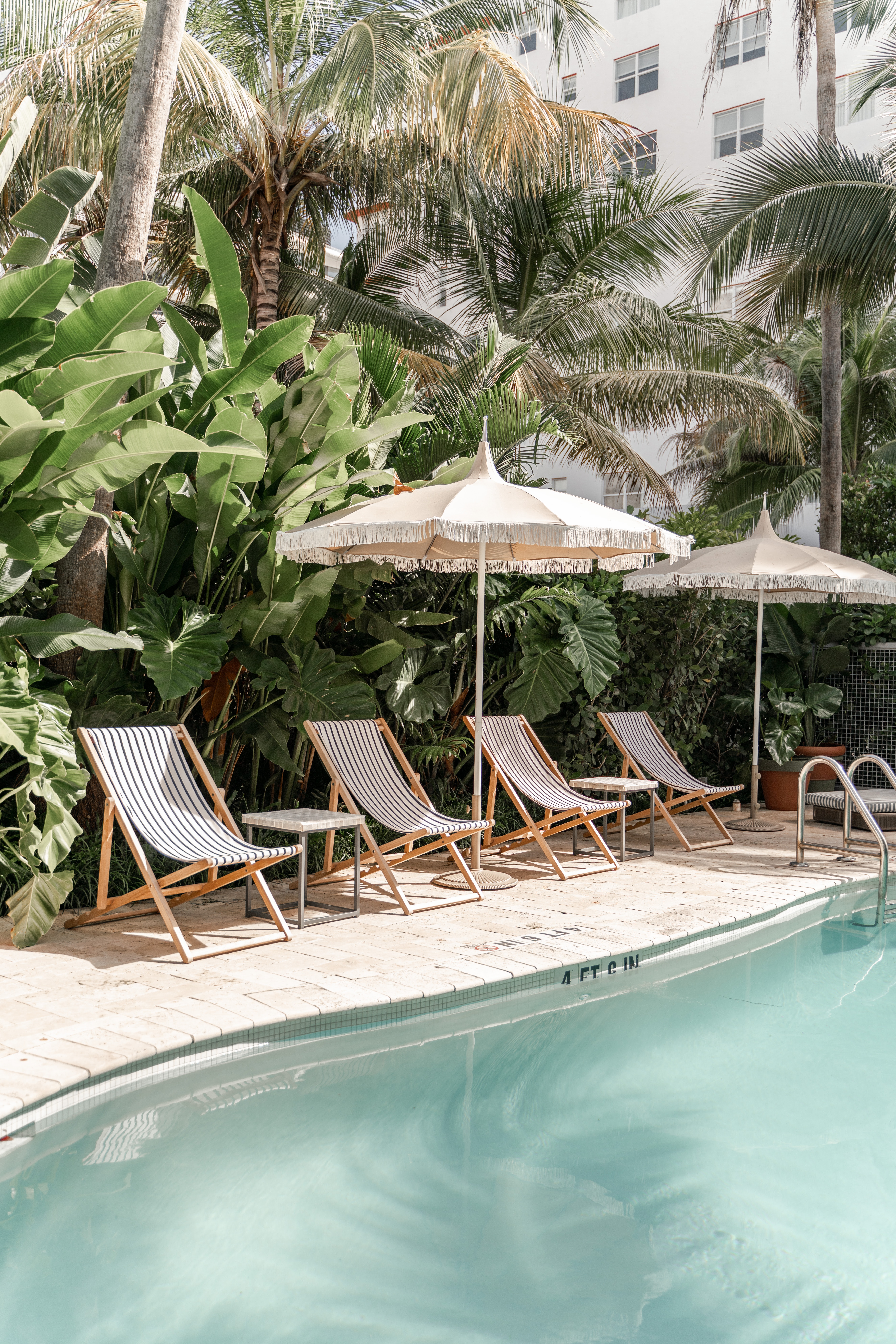
However, papyrus is not frost tolerance and will not do well in extremely cold temperatures. Where possible, it should be moved inside during winter. Otherwise Egyptian papyrus is easy to grow. It prefers full sun but can handle partial shade as well. Plant the rhizomes in moist, fertile soil in pots then submerge in an aquatic environment. Or, plant m deep into a muddy substrate that will be capable of holding the heavy stems upright. Papyrus needs to be kept moist if not submerged in order to grow successfully. Pruning isn’t normally necessary, aside from removing dead, broken, or errant stems. You can give it a balanced fertilise in spring to support the growth of the stems but this isn’t necessary. Finally, keep a watchful eye out for rust fungus, a disease that will discolour the stems and foliage.
Caring for Poolside Plants
When it comes to keeping your poolside plants thriving, remember to keep them well watered. These plants are going to be exposed to full sun in most cases, so the soil will dry out faster than other areas of your garden. So keep an eye on the moisture levels in your soil. You should also make sure you leave appropriate space between plants. This allows plenty of space for their roots to spread without plants outcompeting each other. And by fertilising at least once a year you will encourage a healthy bloom of flowers among your flowering poolside plants.
Finally, if you have a saltwater chlorinated pool, you will need to keep your plants a fair distance from the water. Otherwise you may find that the water burns the foliage at best, or could kill some of your plants at worst. Not sure what plants best suit your saltwater pool? Come in to your local Aumanns Nursery and Garden Supplies. Our helpful staff can help you find the perfect poolside plants!

